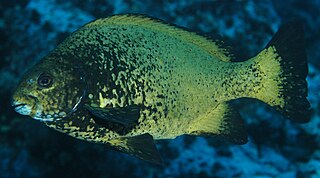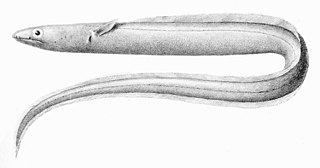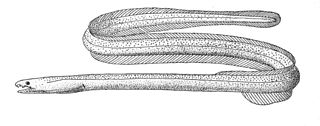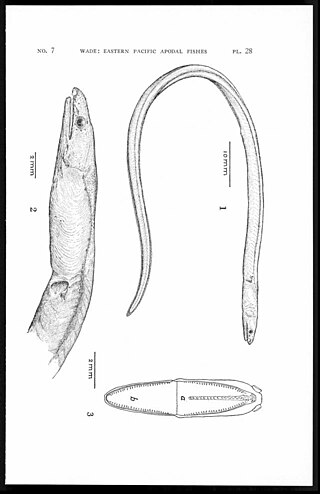
The sea chubs, also known as rudderfish and pilot fish and in Hawaiian as enenue or nenue, are a family, Kyphosidae, of fishes in the order Perciformes native to the Atlantic, Indian and Pacific Oceans usually close to shore in marine waters.

Pseudolabrus is a genus of wrasses native to the eastern Indian Ocean and the Pacific Ocean.

Crenimugil is a genus of mullets found in coastal marine waters and rivers in the Indo-Pacific region.

Moringua is a genus of eels of marine ray-finned fishes belonging to the family Moringuidae, the spaghetti eels. These eels occur in shallow tropical and subtropical waters.

Brachysomophis is a genus of eels in the snake eel family Ophichthidae.

Echelus is a genus of eels in the snake-eel family Ophichthidae.
Hyphalophis is a monospecific genus of marine ray-finned fish belonging to the family Ophichthidae, the snake eels. The only member of this genus is Hyphalophis devius, a species known only from its holotype which was collected in the Lesser Antilles southwest of Grenada.
Kertomichthys is a monospecific genus of marine ray-finned fish belonging to the family Ophichthidae, the snake eels. The only member of this genus is Kertomichthys blastorhinos, a species known only from its holotype which was collected in the Atlantic Ocean in the vicinity of French Guiana.

Lamnostoma is a genus of eels in the snake eel family Ophichthidae. It currently contains the following species:

Leiuranus is a genus of eels in the snake eel family Ophichthidae. It currently contains the following species:

Letharchus is a genus of eels in the snake eel family Ophichthidae. It currently contains the following species:

Muraenichthys is a genus of eels in the snake eel family Ophichthidae.

Pseudomyrophis is a genus of eels in the snake eel family Ophichthidae. It currently contains the following species:
Schultzidia is a genus of eels in the snake eel family Ophichthidae. The name of this genus honors American ichthyologist Leonard Peter Schultz (1901-1986), one of the describers of the type species, Muraenichthys johnstonensis. It currently contains the following species:

Scolecenchelys is a genus of eels in the snake eel family Ophichthidae.
Scolecenchelys iredalei is a species of eel in the worm/snake eel family Ophichthidae. It was first described in the genus Muraenichthys by Gilbert Percy Whitley in 1927 and named in honour of ornithologist-malacologist Tom Iredale from the Australian Museum.
Scolecenchelys puhioilo is an eel in the family Ophichthidae. It was described by John E. McCosker in 1979, originally under the genus Muraenichthys. The specific name puhioilo is derived from Hawaiian puhi oilo, which refers to "small eels about as large in diameter as a finger".

Myrophinae, the worm eels, is a subfamily of ray-finned fishes belonging to the family Ophichthidae, which also includes the snake eels in the subfamily Ophichthinae.

Congroidei is a suborder of ray-finned fishes belonging to the order Anguilliformes, the eels. These eels are mostly marine, although a few species of snake eel will enter freshwater, and they are found in tropical and tempareate waters throughout the world.
Pylorobranchus hearstorum, the gigantic worm eel, is a species of marine ray-finned fish belonging to the subfamily Myrophinae, the worm eels, in the family Ophichthidae, which also includes the snake eels. This species is known from a single specimen, the holotype collected from the Verde Island Passage in the Philippines at 13.583-13.575°N, 120.382-120.411°E from a depth between 892 and 966 m. The species was described in 2014 by the American marine biologist John E. McCosker. The specific name honours the friends of McCosker and philanthropists William and Margaret Hearst, who sponsored the expedition the holotype was collected on. This single known specimen of this species had a total length of 121.8 cm (48.0 in).














